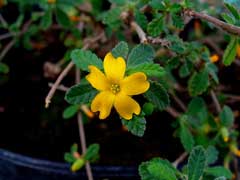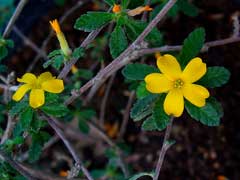 |
|
commons.wikimedia.org/wiki/User:Llez |
 |
| http://commons.wikimedia.org/wiki/User:LlezSatureja montana |
Translate this page:
Summary
UPDATE 12/03/2012: Turnera diffusa var. aphrodisiaca (Ward) Urb. is a synonym of Turnera diffusa Willd. ex Schult.
Physical Characteristics

 Turnera diffusa aphrodisiaca is a deciduous Shrub growing to 1 m (3ft 3in) by 0.6 m (2ft).
Turnera diffusa aphrodisiaca is a deciduous Shrub growing to 1 m (3ft 3in) by 0.6 m (2ft).
See above for USDA hardiness. It is hardy to UK zone 9 and is frost tender. It is in flower from July to August. The species is hermaphrodite (has both male and female organs).
Suitable for: light (sandy), medium (loamy) and heavy (clay) soils and prefers well-drained soil. Suitable pH: mildly acid, neutral and basic (mildly alkaline) soils. It cannot grow in the shade. It prefers dry soil.
UK Hardiness Map
US Hardiness Map
Synonyms
Turnera diffusa
Plant Habitats
Woodland Garden Sunny Edge; South Wall. By. West Wall. By.
Edible Uses
Edible Parts:
Edible Uses: Tea
The leaves are used as a tea substitute and also as a flavouring in liqueurs[254]. They have a strongly aromatic slightly bitter taste[254].
References More on Edible Uses
Medicinal Uses
Plants For A Future can not take any responsibility for any adverse effects from the use of plants. Always seek advice from a professional before using a plant medicinally.
Digestive Infertility Tonic Urinary
Damiana was a traditional aphrodisiac of the Maya people in Central America. It continues to be considered valuable as an aphrodisiac and general tonic, and its stimulant tonic action makes it a valuable remedy for those suffering from mild depression[254]. The whole plant is a bitter, pungent, warming herb with a fig-like flavour[238]. Its use improves the digestion, lifts the spirits, calms the nerves, regulates hormonal activity, stimulates the genito-urinary tract and rejuvenates kidney energy[238]. It is used internally to treat nervous exhaustion, anxiety, depression, debility in convalescence, impotence, premature ejaculation, prostate complaints, urinary infections, frigidity, vaginal discharge, painful menstruation, menopausal problems, poor appetite and digestion, and atonic constipation[238]. The plants are harvested when in flower and are dried for later use[238].
References More on Medicinal Uses
The Bookshop: Edible Plant Books
Our Latest books on Perennial Plants For Food Forests and Permaculture Gardens in paperback or digital formats.

Edible Tropical Plants
Food Forest Plants for Hotter Conditions: 250+ Plants For Tropical Food Forests & Permaculture Gardens.
More

Edible Temperate Plants
Plants for Your Food Forest: 500 Plants for Temperate Food Forests & Permaculture Gardens.
More

More Books
PFAF have eight books available in paperback and digital formats. Browse the shop for more information.
Shop Now
Other Uses
References More on Other Uses
Cultivation details
Requires a dry soil in a warm sunny sheltered position[238]. One report says that this species is hardy to about -5°c[238], though this needs to be treated with some caution considering its native range is entirely tropical[K]. It is possible that, whilst the plant will be cut back to the ground by cold weather, the rootstock is hardier and will re-sprout in the spring[K]. It will certainly be worthwhile trying the plant outdoors and giving the roots a thick protective mulch in the autumn[K].
References Carbon Farming Information and Carbon Sequestration Information
Temperature Converter
Type a value in the Celsius field to convert the value to Fahrenheit:
Fahrenheit:
The PFAF Bookshop
Plants For A Future have a number of books available in paperback and digital form. Book titles include Edible Plants, Edible Perennials, Edible Trees,Edible Shrubs, Woodland Gardening, and Temperate Food Forest Plants. Our new book is Food Forest Plants For Hotter Conditions (Tropical and Sub-Tropical).
Shop Now
Plant Propagation
Seed - sow spring in a greenhouse[238]. Prick out the seedlings into individual pots once they are large enough to handle and grow them on in the greenhouse for at least their first winter. Plant them out into their permanent positions in early summer and give some protection from winter cold for at least their first winter outdoors. Division in spring or autumn[238]. Cuttings of half-ripe wood, July/August in a frame. Overwinter the young plants in a greenhouse and plant them out in early summer.
Other Names
If available other names are mentioned here
Native Plant Search
Search over 900 plants ideal for food forests and permaculture gardens. Filter to search native plants to your area. The plants selected are the plants in our book 'Plants For Your Food Forest: 500 Plants for Temperate Food Forests and Permaculture Gardens, as well as plants chosen for our forthcoming related books for Tropical/Hot Wet Climates and Mediterranean/Hot Dry Climates. Native Plant Search
Found In
Countries where the plant has been found are listed here if the information is available
Weed Potential
Right plant wrong place. We are currently updating this section.
Please note that a plant may be invasive in one area but may not in your area so it’s worth checking.
Conservation Status
IUCN Red List of Threatened Plants Status :

Growth: S = slow M = medium F = fast. Soil: L = light (sandy) M = medium H = heavy (clay). pH: A = acid N = neutral B = basic (alkaline). Shade: F = full shade S = semi-shade N = no shade. Moisture: D = dry M = Moist We = wet Wa = water.

Expert comment
Author
(G.H. Ward) Urban.
Botanical References
Links / References
For a list of references used on this page please go here
Readers comment